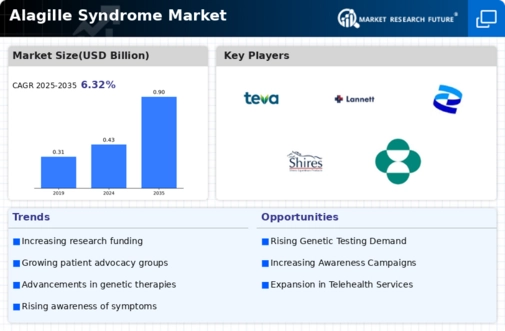Market Growth Projections
The Global Alagille Syndrome Market Industry is projected to experience substantial growth over the next decade. With an estimated market value of 0.43 USD Billion in 2024, it is anticipated to reach approximately 0.9 USD Billion by 2035. This growth trajectory indicates a compound annual growth rate (CAGR) of 6.96% from 2025 to 2035. Such projections underscore the increasing recognition of Alagille Syndrome and the corresponding demand for effective treatments. As the market evolves, stakeholders are likely to focus on innovative solutions and patient-centered care to address the needs of individuals affected by this rare genetic disorder.
Emerging Therapeutic Options
The emergence of new therapeutic options is a vital driver for the Global Alagille Syndrome Market Industry. Recent developments in treatment modalities, including pharmacological interventions and surgical options, are providing new hope for patients. Innovative therapies targeting the underlying genetic causes of Alagille Syndrome are being explored, which may lead to more effective management strategies. The introduction of these therapies is expected to enhance patient quality of life and drive market growth. As the landscape of treatment options evolves, the market is likely to expand, reflecting the increasing demand for effective solutions to manage this complex disorder.
Growing Awareness and Advocacy
Growing awareness and advocacy for Alagille Syndrome significantly influence the Global Alagille Syndrome Market Industry. Patient advocacy groups and healthcare organizations are actively promoting education about the disorder, which helps in early diagnosis and treatment. Campaigns aimed at raising awareness have led to increased screening and genetic testing, thereby identifying more patients who require care. This heightened awareness not only improves patient outcomes but also stimulates demand for healthcare services and therapies. As advocacy efforts continue to expand, the market is likely to experience sustained growth, reflecting the needs of a more informed patient population.
Advancements in Genetic Research
Advancements in genetic research play a crucial role in the Global Alagille Syndrome Market Industry. The identification of specific genetic mutations associated with Alagille Syndrome has led to improved diagnostic techniques and targeted therapies. For instance, the discovery of mutations in the JAG1 and NOTCH2 genes has facilitated genetic testing, enabling earlier diagnosis and personalized treatment plans. This progress not only enhances patient outcomes but also drives the demand for innovative therapies. As research continues to evolve, the market is likely to expand, reflecting the growing need for specialized care and management of this complex condition.
Rising Prevalence of Alagille Syndrome
The increasing prevalence of Alagille Syndrome globally is a primary driver for the Global Alagille Syndrome Market Industry. Recent estimates suggest that the incidence of this genetic disorder ranges from 1 in 30,000 to 1 in 50,000 live births. As awareness grows, more cases are being diagnosed, which contributes to the demand for effective treatment options. This rising prevalence is expected to significantly impact market growth, with projections indicating that the market could reach approximately 0.43 USD Billion in 2024 and potentially 0.9 USD Billion by 2035, reflecting a robust CAGR of 6.96% from 2025 to 2035.
Increased Investment in Rare Disease Research
The Global Alagille Syndrome Market Industry benefits from increased investment in research focused on rare diseases. Governments and private organizations are allocating more resources to understand and treat conditions like Alagille Syndrome. This trend is evidenced by various funding initiatives aimed at developing new therapies and improving patient care. The commitment to rare disease research is expected to foster innovation, leading to the introduction of novel treatment options. As a result, the market is poised for growth, driven by the influx of funding and the potential for breakthroughs in therapeutic approaches.















